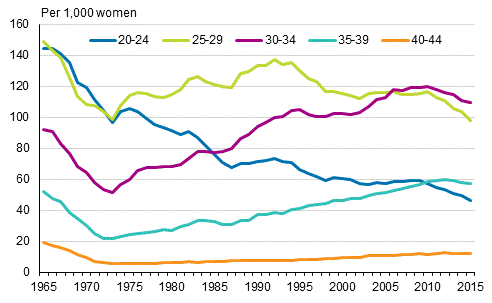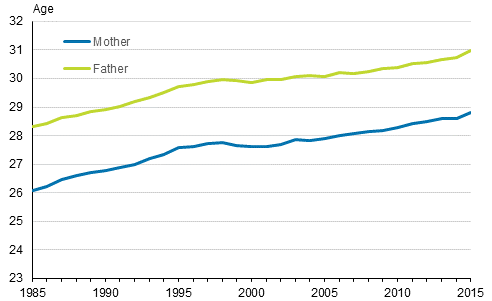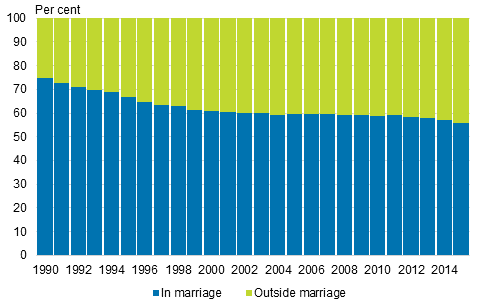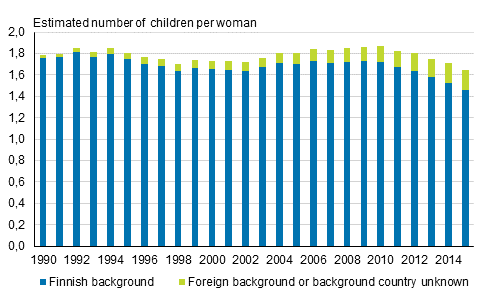Published: 8 December 2016
Having children is most common in the 30 to 34 age group
According to Statistics Finland's data on population changes, having children is now most common for those aged 30 to 34, slightly more common than for those aged 25 to 29. In relative terms, more children are born to those aged 35 to 39 than to persons aged 20 to 24, whose birth rate has lowered considerably in recent years. The birth rate among those aged 40 to 44 has continued its slight growth, which started in the mid-1970s. In the past five years, the birth rate has declined clearly among those aged 20 to 34.
Fertility by age group 1965–2015

The share of persons aged 30 and over in total fertility was 54 per cent in 2015. At the beginning of the 1970s, it was one quarter. The threshold of 50 per cent was exceeded in 2008. The total fertility rate indicates how many children a women would give birth to calculatorily during her life time if age group-specific fertility rates remained the same as in the year on which the calculation is based.
The fertility rate of persons aged 35 to 44 has risen considerably, from 22 children born per thousand women to 36 children per thousand women.
First children are born to women aged 35 to 39 clearly more often than before. When in 1990 six women per thousand women in this age group gave birth to their first child, in 2015 the corresponding figure had grown to 14. Because people start having children later, first-time mothers and fathers are ever older. The average age of first-time mothers was 28.8 years and that of fathers 31.0 years in 2015.
First live birth by mother’s and father’s mean age 1985–2015

The age difference of first-time parents has stayed almost unchanged for at least 30 years. First-time fathers are slightly over two years older than first-time mothers.
First-time mothers and fathers are slightly older in the Nordic countries than in Finland, except for Iceland. Women becoming mothers are, on average, oldest in Sweden, 29.1 years, and youngest in Iceland, 27.4 years. Correspondingly, first-time fathers are also oldest in Sweden, 31.5 years, and youngest in Iceland, 30 years.
Number of children born in marriage has decreased
More than one-half of children, 56 per cent, were born to married parents in 2015. The number and share of children born to married couples have diminished in recent decades. In 1990, as many as three out of four children were born to married couples.
A total of 35,900 children were born to married couples in 2010, only 30,900 in 2015. In the period mentioned above, the number of marriages entered into also went down clearly. In 2015, the number of marriages entered into was 5,200 lower than five years earlier. A considerably big drop took place in 2015, when 1,800 fewer children were born to married parents than in the previous year.
Live births in marriage and outside marriage 1990–2015, per cent

The number of children born in marriage declined particularly for first-born children, of whom 1,300 fewer were born in 2015 than in the year before. The number of first children born outside marriage remained almost unchanged from the previous year. The majority of children born outside marriage were born to cohabiting parents.
Fifty-seven per cent of first children were born outside marriage in 2015, while the percentage was 38 in 1990. The threshold of 50 per cent was exceeded in 1997. Of second or higher order children, 35 per cent were born outside marriage. In 1990, the corresponding percentage was 17.
In relative terms, most children were born outside marriage in Iceland of European countries, 70 per cent of children born. According to the most recent data of Eurostat, the Statistical Office of the European Union, the lowest number of children in European countries were born outside marriage in relative terms in Greece, eight per cent, in 2014.
Share of persons with Finnish background in the birth rate smaller than before
As the share of people with Finnish background in the birth rate has gradually fallen, that of persons with foreign background has correspondingly grown. In 1990, the birth rate of persons with Finnish background was practically the same at the total population's birth rate, because there were so few persons with foreign background in Finland. In 25 years, the share of persons with foreign background in the birth rate of the entire country has slowly grown and now corresponds to 11.5 per cent of the whole country's birth rate. In the corresponding time, the share of women with foreign background in all women aged 15 to 49 has grown slightly slower, however, to 8.8 per cent.
The share of persons with Finnish background in the birth rate has gone down by 16 per cent in the past five years. According to the birth rate in 2015, the average number of children for a woman with Finnish background would be 1.46 children per woman measured by the total fertility rate, when in 2010 it was still 1.73. According to the whole country's birth rate in 2015, women's average number of children would be 1.65 children per women, of which the share of persons with foreign background is 0.19 child per woman.
Total fertility rate by mother’s origin 1990–2015

Further information about the birth rate according to origin is available on Statistics Finland's Immigrants and integration thematic pages in the section birth rate (in Finnish only).
Source: Births 2015. Statistics Finland
Inquiries: Timo Nikander 029 551 3250, info@stat.fi
Director in charge: Jari Tarkoma
Publication in pdf-format (270.7 kB)
- Tables
-
Tables in databases
Pick the data you need into tables, view the data as graphs, or download the data for your use.
Appendix tables
- Quality descriptions
-
- Quality description, births 2015 (8.12.2016)
Updated 08.12.2016
Official Statistics of Finland (OSF):
Births [e-publication].
ISSN=1798-2413. Annual Review 2015. Helsinki: Statistics Finland [referred: 9.11.2024].
Access method: http://www.stat.fi/til/synt/2015/02/synt_2015_02_2016-12-08_tie_001_en.html

